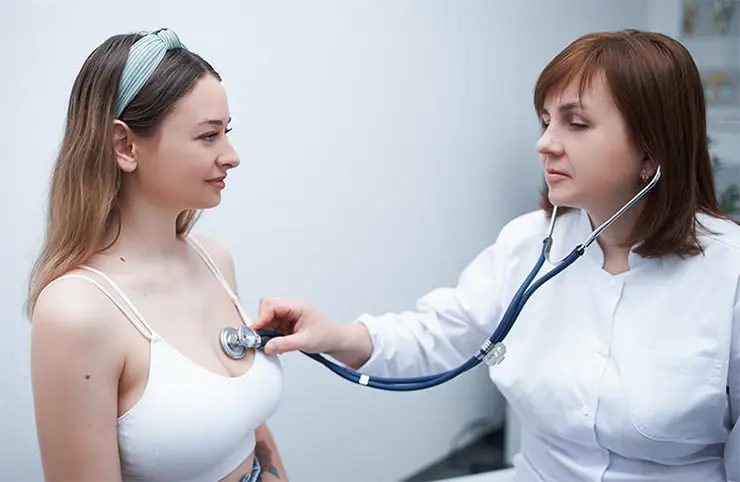
What is cardiac tachycardia in adolescents, why does it occur? Why is tachycardia dangerous, symptoms, diagnosis. First aid and general therapy. Prevention of pathology in adolescence.
The content of the article:- What is tachycardia in a teenager
- Causes
- Main features
- Treatment options
- First aid
- General therapy
- Prevention
Cardiac tachycardia in a teenager is a physiological condition that can be assessed both as a normal variant and as evidence of pathological processes in the body. A feature of the occurrence of cardiac tachycardia in a teenager is the active development of the cardiovascular system in general and the heart in particular, which occurs during this period. It is possible to distinguish natural processes from pathology only with systematic monitoring of health status in a children's clinic. If necessary, parents should insist on treatment of the pathology, strictly following the doctor’s recommendations.
- Related article: tachycardia during pregnancy
What is tachycardia in a teenager?
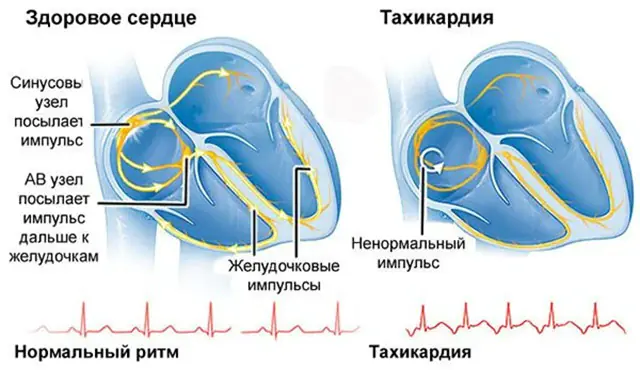
“Tachus” is translated from Greek as “fast”, and “cardio” means heart. This term refers to rapid heartbeat, regardless of the reasons that caused it. Physiologically accelerated contraction of the myocardium provokes compensatory mechanisms of the body during moments of physical or emotional stress. However, the pathological processes of tachycardia in a teenager 15 years of age or younger lead to insufficient oxygen supply to the internal organs and myocardial tissue. Which in turn can cause inhibition in development or more serious complications of the cardiovascular system.
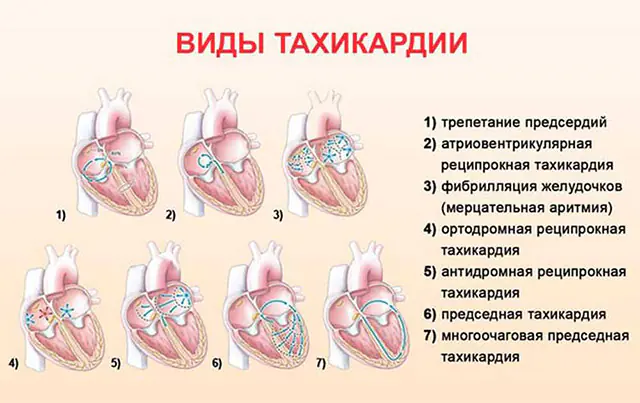
The photo shows the types of tachycardia
Tachycardia in a 14-year-old teenager (and in some cases for girls 12) is complicated by individual developmental characteristics. In a newborn, a pulse of 140 is considered normal, and by the age of 12 the number of heartbeats decreases to 60-80. At the same time, the heart itself actively grows in the first year of life and during puberty (13-16 years). In this case, the lumen of the vessels does not have time to expand in accordance with the increase in heart volume, which leads to an increase in pressure in the system or the frequency of contractions.
The second physiological provocateur of teenage tachycardia is the small size of the heart with an asthenic type of physiology. Such tachycardia in a 17-year-old teenager is not uncommon; boys or girls are tall and relatively light in weight. The small heart is forced to contract faster to ensure normal blood supply to the periphery.
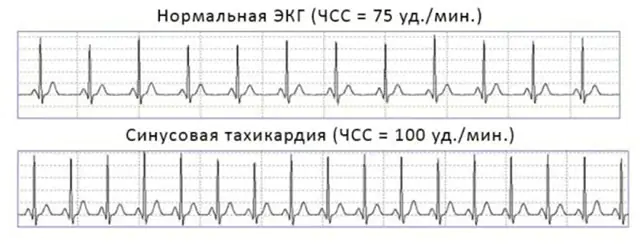
The photo shows sinus tachycardia
Boys and girls whose resting pulse is higher than normal should come under medical supervision. And although after active physical work the youthful cardiovascular system is able to withstand a load of 200 beats per minute, at rest the heart should not contract more than 90 beats. For 13-16 years old, the average heart rate is 70-78 beats per minute. If systematic measurements show more, it is necessary to look for the causes of tachycardia in a teenager and begin treatment before the development of irreversible pathogenic processes.
Causes of tachycardia in a teenager
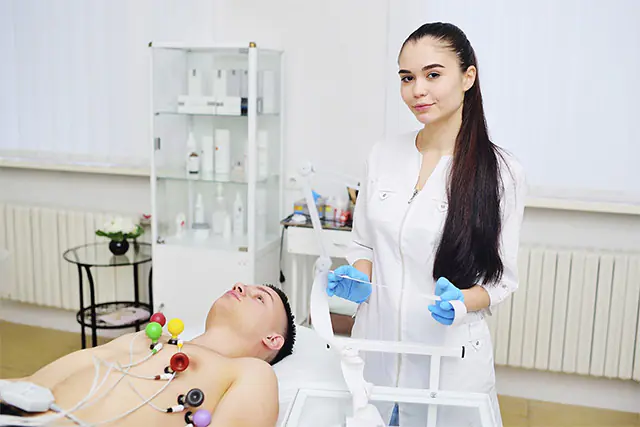
If your heart begins to beat faster after physical activity or intense experiences, this is a natural process caused by the body's response to increased stress.
Pathological tachycardia in adolescence is provoked by a number of factors:
- Congenital heart defects - as a rule, parents are aware of this disease and know what to do during attacks of tachycardia in a teenager 13 years of age and older. In this case, it is necessary to control the disease and stop the progression of the clinical picture of the pathology.
- Hormonal imbalance caused by changes in the endocrine system.
- Infectious diseases or cancers affecting myocardial tissue.
- Treatment with medications that provoke tachycardia in a teenager (at 16 years old, for example, glucocorticoids can be used for therapeutic purposes).
Identifying and stopping the causes of tachycardia in adolescents is more likely to get rid of the unpleasant clinical picture.
The main signs of tachycardia in adolescents
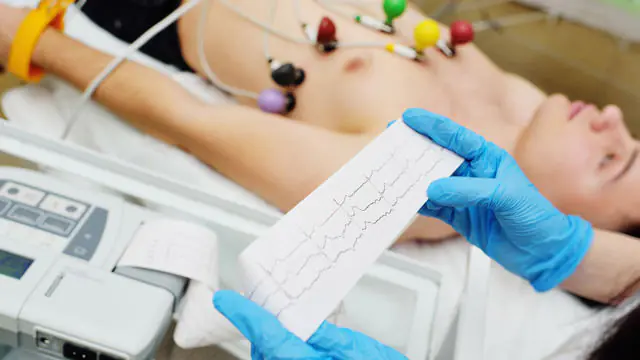
Symptoms of tachycardia in a teenager depend on the pathophysiology of the process. If rhythm disturbances are caused by dysfunction of the sinoatrial node, then the heart rate increases significantly with a relatively stable rhythm. Sinus tachycardia occurs in a 12-year-old teenager even after emotional stress. More often this condition is caused by anemia in girls entering fertile age.
The paroxysmal type of pathology is characterized by acute attacks that last from several minutes to several hours.
The patient's condition may be aggravated by other symptoms:
- dizziness up to loss of consciousness;
- weakness of the body;
- pain in the chest or behind the heart (in rare cases, pain radiates to the stomach);
- noise in the ears and head.
The progression of the clinical picture indicates the development of complications, so the sooner the disease is diagnosed and treatment of tachycardia in adolescents is started, the less likely it is that irreversible destructive processes will begin in the cardiovascular system.
Important! The first symptoms of the disease cannot be visually assessed. Parents should be attentive to the child’s complaints and respond to any signs of cardiac tachycardia in a teenager.
If parents accidentally discover a high heart rate in a child, it is necessary to clarify what preceded this condition - physical activity, nervous experience or rest. You should also clarify how often such situations occur. You can independently measure your pulse throughout the day. If you suspect tachycardia in a teenager 12-17 years old, you should contact a cardiologist.
Only after a thorough examination will the causes of rapid heartbeat be determined and adequate treatment prescribed.
To identify provocateurs of cardiac tachycardia in adolescents, the following are prescribed:
- a general blood and urine test to assess the patient’s condition and identify potential inflammatory processes;
- blood test for hormones - to assess the functionality of the thyroid gland;
- Ultrasound or MRI of the heart to assess possible structural pathologies;
- echocardiography and Holter electrocardiogram: since adolescent tachycardia may not manifest itself at rest, doctors prescribe daily monitoring of the patient’s condition.
At the diagnostic stage, the patient’s condition is assessed taking into account age-related physiological characteristics. Further treatment of tachycardia in adolescents will depend on the diagnosed provoking disease.
Methods for treating tachycardia in adolescents
A feature of the treatment of tachycardia in a teenager at 16-17 years of age, as at a younger age, is the limitation of general medication practice. It is permissible to take certain drugs only from 18 years of age. Treatment tactics are selected exclusively by the attending physician, based on diagnostic data. Therapy should be effective, but gentle on the teenage body. Parents need to ensure strict compliance with medical recommendations, and also know how tachycardia is treated in adolescents at the time of an attack.
- Read also about the treatment of tachycardia with folk remedies
First aid for an attack of tachycardia in a teenager
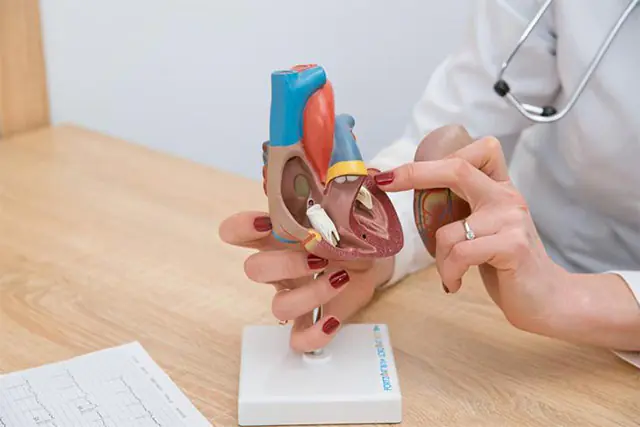
The question of what to do if a teenager has an attack of tachycardia also causes palpitations in parents, since such paroxysms are not expected at a young age. Meanwhile, it is extremely important to properly provide first aid to a teenager in order to minimize the harmful impact of the condition on the child’s overall well-being.
The first aid algorithm for tachycardia in adolescence is the same as for adults:
- Place the child in a chair.
- Free the collar area from clothing (unbutton the collar or remove the shirt completely).
- Open the window in the room (you can take the teenager outside).
- Wash with cold water or apply an ice compress to the neck and head.
- Do a breathing exercise together: inhale slowly, hold your breath, exhale sharply.
With sinus tachycardia in adolescents 15-17 years old, breathing exercises relieve pathological symptoms. However, if this does not happen, emergency assistance should be called.
Note! While adults can be given sedatives to calm them down, at a young age such a measure is only permissible with the permission of a doctor. At the first attack, taking medications is not advisable.General therapy of tachycardia in a teenager

The program on how to treat tachycardia in a teenager is prescribed individually by the attending physician and necessarily includes recommendations for general health promotion.
What to do with tachycardia in adolescents:
- provide the child with adequate rest (8 hours of sleep at night, daytime rest if necessary);
- rational nutrition taking into account the active physiological development of the child;
- daily intake of vitamins and minerals appropriate for the child’s age and physical activity;
- moderate sports loads, for example, tachycardia in adolescents 14 years old can occur during periods of passion for weightlifting, and at this age it is better to transfer the child’s attention to other sports;
- control of the child’s emotional state.
Drug treatment is prescribed strictly individually. When infections are diagnosed, antibiotics may be prescribed, and dysfunction of the endocrine system will require hormone therapy. Only from the age of 18 will full-fledged drug therapy with an adult dosage be prescribed.
Important! Self-medication is strictly prohibited! Wrong actions of parents can lead to the development of complications of tachycardia in a teenager. After the first signs of the disease, you should consult a specialist for advice.Prevention of tachycardia in adolescence

Since rapid heart rate is not a pathology, but only evidence of stress on the body or pathological processes, targeted preventive measures against tachycardia in adolescents aged 13-16 years have not been developed. However, pediatricians and cardiologists note that general strengthening measures reduce the number of paroxysms in adolescence.
Doctors recommend:
- fractional meals - the child should have at least 5 meals, the amount of vegetables and fruits is increased, and fatty foods are reduced;
- controlled physical activity - the teenager is recommended to play sports if there are no other medical indications;
- learn to control stress, which is especially important for schoolchildren during exam periods;
- sleep at least 8 hours at night without interruption.
It is also important to talk with your child about the dangers of smoking and drinking alcohol. Often such “tests” end in attacks of tachycardia in a teenager at the age of 16 or even earlier. A trusting relationship between parents and a child will also allow dysfunction to be identified in time, since the teenager will not hide poor health.
Tachycardia in a teenager is not always the body’s usual reaction to stress and tension. There are cases when a rapid heartbeat indicates a serious illness in the child. It is extremely important that parents identify symptoms of tachycardia in a teenager before the clinical picture expands. It is also important to know what to do if a teenager has paroxysmal tachycardia, how to help during an attack. Attentive attention to health will allow you to normalize your condition and raise a healthy person.
Video on the topic: 5 causes of tachycardia - causes of rapid heartbeat:



